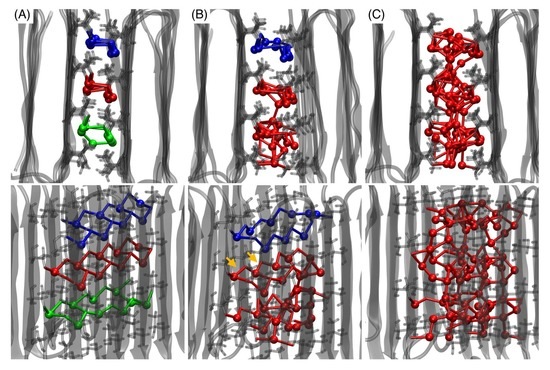MM2019
Kenji Mochizuki and Masakazu Matsumoto
Collective Transformation of Water between Hyperactive Antifreeze Proteins: RiAFPs
Crystals
2019, 9(4), 188.
DOI: 10.3390/cryst9040188

Abstract: We demonstrate, by molecular dynamics simulations, that water confined between a pair of insect hyperactive antifreeze proteins from the longhorn beetle Rhagium inquisitor is discontinuously expelled as the two proteins approach each other at a certain distance. The extensive striped hydrophobic–hydrophilic pattern on the surface, comprising arrays of threonine residues, enables water to form three independent ice channels through the assistance of hydroxyl groups, even at 300 K. The transformation is reminiscent of a freezing–melting transition rather than a drying transition and governs the stable protein–protein separation in the evaluation of the potential of mean force. The collectivity of water penetration or expulsion and the hysteresis in the time scale of ten nanoseconds predict a potential first-order phase transition at the limit of infinite size and provide a new framework for the water-mediated interaction between solutes.
我々は、分子動力学シミュレーションによって、2つのタンパク質が一定の距離で互いに接近するにつれて、カミキリムシRhagium inquisitorからの一対の昆虫の高活性不凍液タンパク質の間に閉じ込められた水が不連続に排出されることを実証する。 表面にスレオニン残基の配列を含む広範な縞模様の疎水性 - 親水性パターンがあるため、300 Kでも水酸基の助けを借りて3つの独立した氷チャンネルを形成することができます。 平均力ポテンシャルの評価において、乾燥遷移と安定したタンパク質 - タンパク質分離を支配します。 水の浸透または排除の集団性と10ナノ秒の時間スケールでのヒステリシスは、無限サイズの限界での潜在的な一次相転移を予測し、溶質間の水媒介相互作用のための新しいフレームワークを提供します。
research papers 2019 paper2019